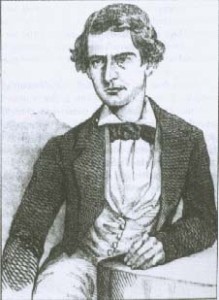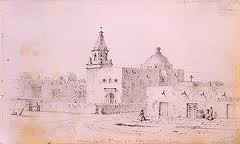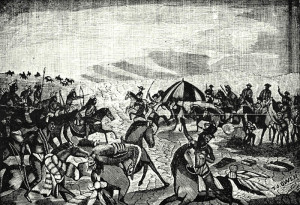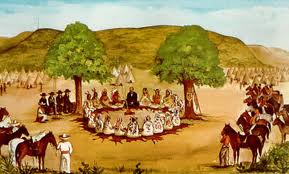Her proper given name was Myra Maybelle Shirley, later shortened to Belle, and she had a lamentable taste for dangerous men and walking on the far side of the law, which eventually brought her to an untimely grave, murdered by the last in that series of dangerous men. Her career brought considerable embarrassment to an otherwise respectable and law-abiding family, who resided near Carthage, Missouri in the year of her birth, 1848. Her father was a Virginian, a prosperous man, a pillar of the community, and a judge – and she was the only daughter in a family of boys. Her father the judge had her expensively schooled in those arts thought proper for a Victorian-era lady of good family at at the local female seminary, where she excelled in French and in playing the piano. Her older brother Bud, more problematically taught her to ride, to shoot, curse like a trooper and love the out-of-doors. A show-off and a bit of a tomboy – how could an independent and spirited girl with five indulgent brothers be anything else?
Alas, the prosperity of the Shirley family took a hit in the period leading up to and during the Civil War, Guerrilla warfare between pro- and anti-slavery sympathizers in Kansas and Missouri spiraled into a vicious partisan war. Kansas bled and Missouri hemorrhaged … and the Shirley family was not spared. Bud Shirley joined William Clark Quantrill’s band at the start of the war, and was killed in a skirmish in the last year. Some versions have it that Myra Maybelle was a spy for Quantrill, or one of his lovers, others that she strapped on a pair of revolvers and took her own revenge for Bud’s death. Such tales are unlikely in the extreme; she would have been a school girl barely into her teens and under the authority of per parents. While her father may have been indulgent – he wouldn’t have been that indulgent. In any case, when Carthage was burned by Confederate guerrillas late in 1863, Judge Shirley had enough. He moved his surviving family to Texas, to a farm in a little town which is now a suburb of Dallas.
A little more than a year after the war ended, several members of the James-Younger gang showed up seeking refuge after pulling off a profitable bank robbery in Liberty, Missouri. The older James and Youngers were comrades of Bud Shirley’s in Quantrill’s band; likely it was not a coincidence they turned up asking hospitality from the family of a comrade, on the grounds that they were still fighting the good fight against the hated Yankee victors. Myra Maybelle was eighteen by then – and she fell heavily for Cole Younger … although possible with equal ardor for another Quantrill veteran from Missouri, one James Reed. In any case, she married James Reed the following year, supposedly running away to the woods and being married there – shades of Robin Hood and Maid Marian. It is a matter of conjecture if her family approved this or any of her subsequent nuptials. If they had objections, they kept them to themselves, being by this time unable to turn their wayward daughter from her chosen course. Perhaps they simply hoped that she was entering into a secure, respectable married life and giving up an unseemly affection for horses, guns and dangerous scoundrels. James Reed – with his own lawless reputation not yet established – must have appeared as much more promising husband material than Cole Younger, who was already wanted across several mid-western states. And Myra Maybelle was well-bred, well-schooled, and existing photographs taken of her in the bloom of youth confirm that she was not unfortunate in looks. Later she did look like a couple of miles of bad road. Possibly in compensation, she developed a taste for flamboyant hats and was usually seen wearing a black-velvet riding habit in the latest style.
For a number of months and possibly years, James Reed managed the straight and narrow with regard to law and order. Myra Maybelle bore two children to him, although rumors persisted that the older of them was actually fathered by Cole Younger. Unfortunately, it turned out that James Reed’s family back in Missouri had a thriving side-line in horse thievery. A rival family ambushed and killed James Reed’s brother – and in the manner of Old West vendettas, James retaliated. He and Myra Maybelle fled the resulting murder warrants … all the way to California, which afforded a safe refuge, until the local constabulary discovered the warrants … and there was a little matter of a stagecoach robbery near San Diego. The Reeds returned to Texas, Myra Maybelle to her long-suffering family, and James to Oklahoma … to a refuge in a remote hide-out in the Cherokee part of Indian Territory.
This was a small settlement on the Canadian River between Briartown and Eufala, the home of Tom Starr and his extended clan of sons, daughters, cousins, in-laws … and outlaws. Tom Starr had been such a violent partisan of the Confederate faction of the Cherokees that at the end of the war he was essentially bribed into behaving himself. Myra Maybelle visited often to see her husband – where she would have met Tom Starr’s son Sam – or James traveled to Scyene to see her. But by 1873, she had dispatched the children to relatives and was running a livery stable in Dallas … a stable which also served the essential function as a front for disposing of stolen horses. Contra popular movies and television, horse thievery was a profitable business, and not one in ten of professional thieves were ever caught. Myra Maybelle was perfectly situated: Dallas was a thriving boom-town, the center of trade and commerce in cattle and cotton, on the intersection of two major railways. She was intelligent and literate, in the ideal location to plan crimes, fence the stolen horses, and to ensure that those of her associates unwary or unlucky enough to be caught were defended against legal charges. She was literate, and intelligent – and in a perfect location to both plan crimes, to fence the stolen property afterwards, and to see that those of her associates unwary – or unlucky – enough to be caught were defended against the charges, one way or another. But was she really the ‘bandit queen’, the brains behind a motley gang of thieves of every description – or merely a thrill-seeker and enabler of violent men? Alas, the facts are in considerable dispute among historians and folklorists, since they were obscured by the interests of sensational newspaper stories and dime novels about the wild, wild west – a process which had Myra Maybelle’s enthusiastic cooperation.
On one of his conjugal visits to Dallas, James Reed joined some of his good bad friends and robbed the San Antonio to Austin stage – but didn’t get to enjoy his share of the loot for long, as he was subsequently shot and killed by a local deputy sheriff. When Myra Maybelle was called to ID the remains (there was a substantial reward in the offing for James Reed, dead or alive) she supposedly claimed the deputy had killed the wrong man – leaving the lawman unrewarded.
Around 1880, Myra Maybelle married Sam Starr, and gained the surname by which she is best known – Belle Starr. The reconstructed family settled in a small house overlooking the Canadian River, which property she named Younger’s Bend, and she gave an interview to a Dallas newspaper in the mid-1880s claiming that she was the model of upright propriety, and there was no woman in the world more peaceably inclined than herself … but alas, the cozy house at Younger’s Bend was the center for an active bandit gang – just one of many in Indian Territory, the last outpost of the lawless wild west. She and the hubby-of-the-moment were charged with stealing horses, and brought before the great Judge Parker in Fort Smith. The pair were found guilty and sentenced to a year in prison. Belle Starr improved the idle hours of confinement by writing a memoir of her life and tutoring the warden’s children in music and French. She and Sam returned to Younger’s Bend on release … where, after another accusation of armed robbery, Sam Starr was killed in a blazing gun battle with a local deputy with whom he had tangled before.
Her final husband was a Creek Indian, who moved into the Younger’s Bend house. Jim July was handsome, educated, half her age and – like many of her amorous and professional associates – a professional horse thief. Early in February, 1889, he departed for Fort Smith, to answer the latest round of criminal charges against him. Belle rode along with him for a short distance, before returning to Younger’s Bend. She stopped to visit a neighbor’s wife and while there, another neighbor stopped by. This neighbor wanted to lease a portion of her property. She had so far refused to do so, and the neighbor was irate. His name was E. A. Watson; local rumor had it that he was wanted in Florida for murder. In the course of the argument, Watson remarked slightingly about the frequency with which officers of the law came to visit Younger’s Bend in the course of their professional duties. Stung, Belle Starr shot back, “Maybe the officers in Florida would like to know where to find you?” and made an angry departure.
Everyone assumed this meant Watson was certain-sure that she was going to inform on him. He is assumed to have gone home, armed himself with a shotgun, and waited for Belle Star to ride past. A little way up the trail, two men waiting for a crude ferry to cross the Canadian River heard two shots and saw Belle Starr’s riderless horse run down the bank and swim across the river. When they back-tracked, they found her body lying in the trail. She had been shot in in the back, thrown from her horse, and then the murderer had made sure with second load of turkey shot as she lay on the ground. Jim July came riding hell-for-leather back from Fort Smith as soon as he heard the news about his wife. His suspicions immediately focused on Watson, who furiously insisted that he was not guilty, although his shotgun was found to have both barrels fired recently and a set of footprints similar to his own had been found, leading from his house to the place where Belle Star had been ambushed, and back to his house again. Watson submitted to being arrested by July, and all parties concerned – the witnesses and Belle’s daughter Pearl trooped off to Fort Smith to testify in the matter. Several curious things; the footprints were only circumstantial evidence, so was the recently-used shotgun. Watson had a good repute among his neighbors, as hard-working and well-liked … and he wasn’t a wanted man, which removed a motivation for murder. He was ordered to be released.
Almost immediately, Jim July skipped out on the original charge … and a deputy marshal who probed a little farther into the murder talked with Watson upon his release. It seemed that Jim July had come to borrow his shotgun on the very day he had departed, claiming that he needed to kill a wolf. When he returned it, an hour later, both barrels had been fired. Watson was certain that July had attempted to frame him. Judge Parker authorized further investigation. It also emerged that one of the neighbors – one of the witnesses who had seen Belle Starr’s horse and discovered the body – had been offered $200 to kill Belle … by her husband. The man had refused immediately, and Jim July had replied, “Hell – I’ll kill the old hag myself and spend the money for whiskey!” When neighbor was asked why July would want to kill his own wife, he explained that July had gotten involved with another woman, and Bell was furious. She would do nothing to help him fight the current charges against him. That provided motivation for the murder. A year later the fugitive Jim July was arrested after a gunfight in Ardmore with the arresting deputies, but died before he could confess anything. Belle Starr’s daughter Pearl had her buried at Younger’s Bend, under a tombstone ornamented with the images of a bell, a star, a hand holding a bunch of flowers, Belle’s favorite horse and the verse, “Shed not for her the bitter tear, Nor give the heart to vain regret; ‘Tis but the casket that lies here, The gem that filled it sparkles yet.”
(These people do not appear in my next book, although the time period and location overlap slightly. I do have a cattle-rustling gang based in Indian Territory as an element, which is loosely based on some of the large organized gangs which thrived there. And John Wesley Hardin wanders in, and out on two occasions. The Quivera Trail will be out in November, 2013. )





Recent Comments